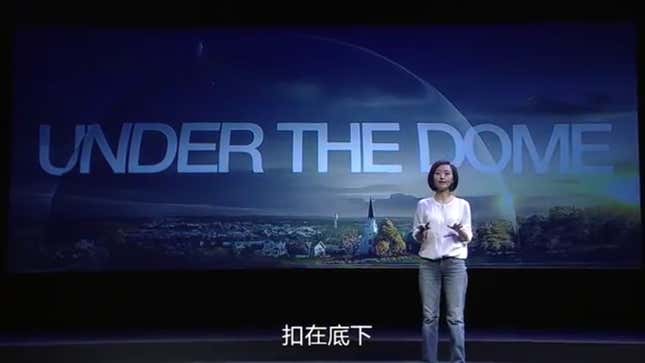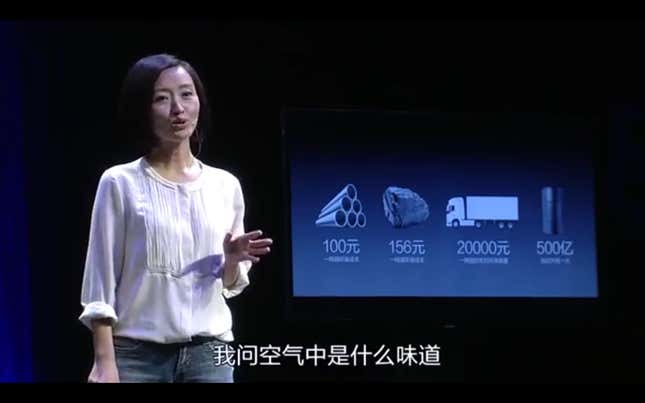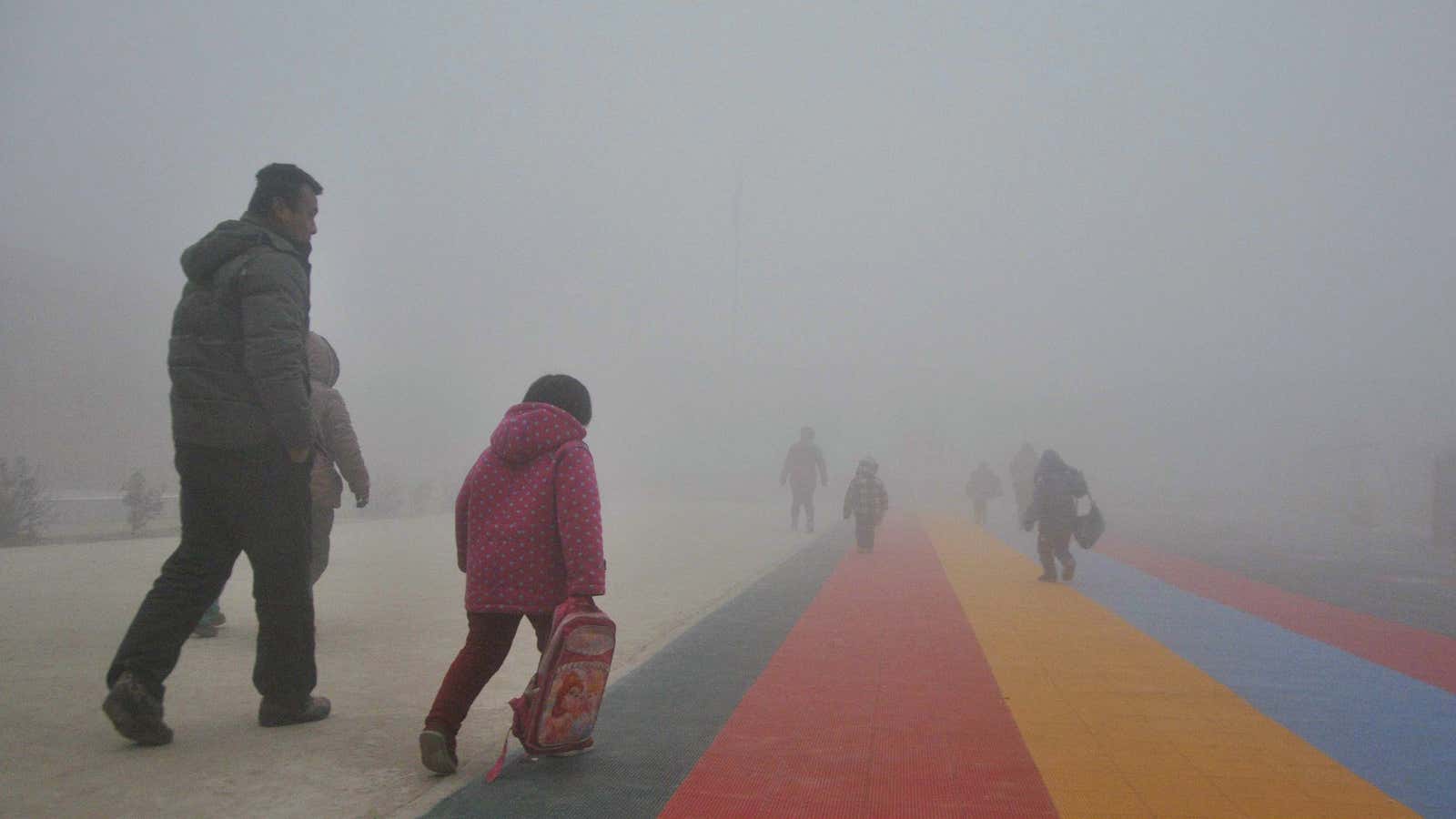A video released over the weekend in China has garnered well over 20 million views on video sharing site YouKu, and close to 5 million on Tencent Video. What’s more, it hasn’t yet been banned. Usually that would describe content like celebrity gossip or comical animals, but this is Under the Dome (link in Chinese), a meticulously researched documentary on the causes and implications of the country’s pollution crisis.
Pollution in China is an inconvenient truth. Nearly everyone agrees it is a problem, but the intricacies, scale, and potential solutions are not well understood. Chai Jing—a former TV news anchor who produced Under the Dome with her own funds—has attempted to tackle the complexities of the issue much as Al Gore did for climate change. In her documentary, Chai purposefully guides viewers through the data on pollution, weaving in interviews with experts, policymakers, and industry representatives.

The documentary—named after the Stephen King book that inspired an American TV series—is novel on many levels. There is an expertly animated section showing how particulate matter infiltrates the lungs. Charts and disturbing images of pollution-ravaged lungs are presented with Gore-like effectiveness. And there are many moving anecdotes from Chai about her personal relationship with pollution, which she believes caused her infant daughter to be born with a benign tumor.
But what’s most surprising is how brazenly Chai attacks some of the most powerful organizations in the country, from the coal and oil industries to the Ministry of Environmental Protection and state-run banks.
Coal
Chai starts her section on coal with a striking figure.
Do you know how much coal China burns? In 2013, we already were burning 3.6 billion tons. And do you know how much coal the rest of the world burns? We burn more than the rest of the world combined.
She makes a trip to a coal factory in Hebei Province to get a firsthand account of production. While there, an environment ministry official falls into a deep hole, unable to see due to the facility being poorly lit. The official, says Chai, was trying to assess whether the factory is properly disposing of its waste. The documentary crew films the incident and the lack of proper waste disposal.
Luckily he wasn’t injured too badly. But what shocked me the most is that, even with such high stakes, even with this hard work, and even though we clearly captured evidence of shoddy drainage systems, in the end the industry was not punished in the least.
Chai goes on to discuss the quality of coal and poor regulation of its disposal.
In recent years, our coal consumption has grown, the quality of the coal has gotten worse, we aren’t cleaning the coal, and there is little regulation of coal disposal. The result is this: In China, the places with higher coal consumption have a much higher concentration of particulate matter.

Regulators and the oil industry
Chai moves on to talk about the impact of oil consumption on air quality, focusing first on vehicle emissions standards. She addresses the fact that, while China’s increasing reliance on cars is partly to blame for poorer air quality, lax regulation of heavy-duty trucks is even more harmful.
She tracks down drivers that have stickers on their trucks claiming that they have been cleared for the “China IV” emissions standards. Checking their engines, however, reveals that they are well below these standards. While there are regulations that can put a stop to these “counterfeit China IV” trucks, she says, they are never enforced.
Are there not regulations that allow us to recall cars that aren’t up to standards? There are. But from 2004 until today, how many times have these laws been used to recall these kinds of cars? Not even once.
Asking why that’s the case, Chai attempts to find out which government department is responsible for enforcing these regulations. She finds a lot of buck passing.
Everybody says, “I don’t know what department is responsible.” So I asked around to find out. I first asked the Ministry of Environmental Protection, they said, “I’ve heard that it’s not us.” Then I asked the Ministry of Industry and Information Technology. They said, “It’s definitely not us.” I then went to the quality supervision department. They said, “I guess it’s all three of us.”
Moving past enforcement, Chai turns to the poor quality of oil used in commercial vehicles. She looks to find out why standards aren’t higher, and finds a revolving door between the oil industry and the regulators meant to keep it in check.
She interviews Yue Xin, a researcher at the Chinese Research Academy of Environmental Sciences, and asks why the standards aren’t higher.
Yue Xin: In the regulator’s technical department, the vast majority—well, the majority—of the members are from the petrochemical industry. Maybe 60% or 70%. In the standards department its even higher, probably over 90% are from the industry.
Banks, subsidies, and zombie companies
Looking for an example of the kind of heavy industry that consumes large amounts of the coal and oil she’s been discussing, Chai zeroes in on steel. She reveals a systemic problem faced by several industries in the country: “zombie” companies, which are uncompetitive and obsolete firms that are kept alive primarily by government subsidies.
In order to prevent the steel industry from declining, the government every other year gave 2 billion renminbi ($320 million) in subsidies. One of the companies that received subsidies was already in rapid decline…so the state-run banks support these so-called “zombie companies,” consuming massive amounts of our resources and exposing our economy to tremendous risk. And these companies are even expanding today.
And later, she makes this into a more general point:
The most important thing for the government to do is not to subsidize obsolete, polluting industries. What it should do is provide fair opportunities for the industries of tomorrow.
What to do about it
Amazingly, given the film’s critical tone and its high-profile targets in government and major Chinese industries, the video has not (yet) been blocked, although state-run news organizations have been directed not to “hype” the documentary further, according to China Digital Times, which monitors leaked censorship instructions.
Since that directive makes clear that the authorities are aware of “Under the Dome,” it’s not clear why Chai has been able to survive the censors.
Perhaps it’s because the video is so measured in its criticism, or that it simply became too popular too fast to shut down. Or maybe the government simply agrees with her message. According to one government report (link in Chinese), newly appointed environment minister Chen Jining said the documentary was “worthy of respect” and thanked Chai for her work.
Even with its popularity, though, Chai is just one former TV anchor. Her lecture closes by imploring others to act.
The reform and opening up of China hasn’t been happening quite the way we’ve been told, like a small bird breaking out of its egg. Its more like a cicada shedding its skin, emerging ever so slowly. Energy is the last part of that shell that needs to be shed.
She tells anyone who is watching to find a way to help, comparing the experience of China to those of countries that have overcome once deadly pollution problems.
If somebody knows that they’ve done something to make things better, they’ll have peace of mind. Looking back on humanity’s battle with pollution, history has been made by thousands of ordinary people who one day say: “No. I’m not satisfied. I don’t want to wait, and I don’t want to pass the buck. I want to stand up and do something. I want to do it here and I want do to it now.”
